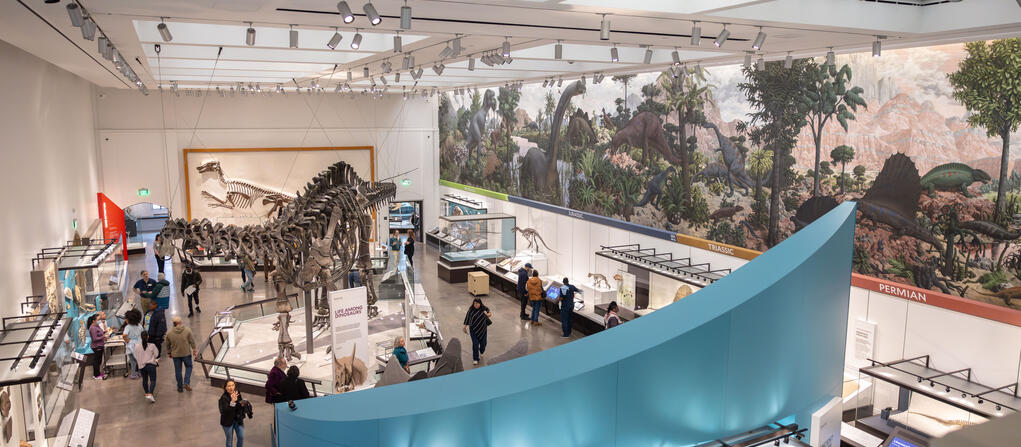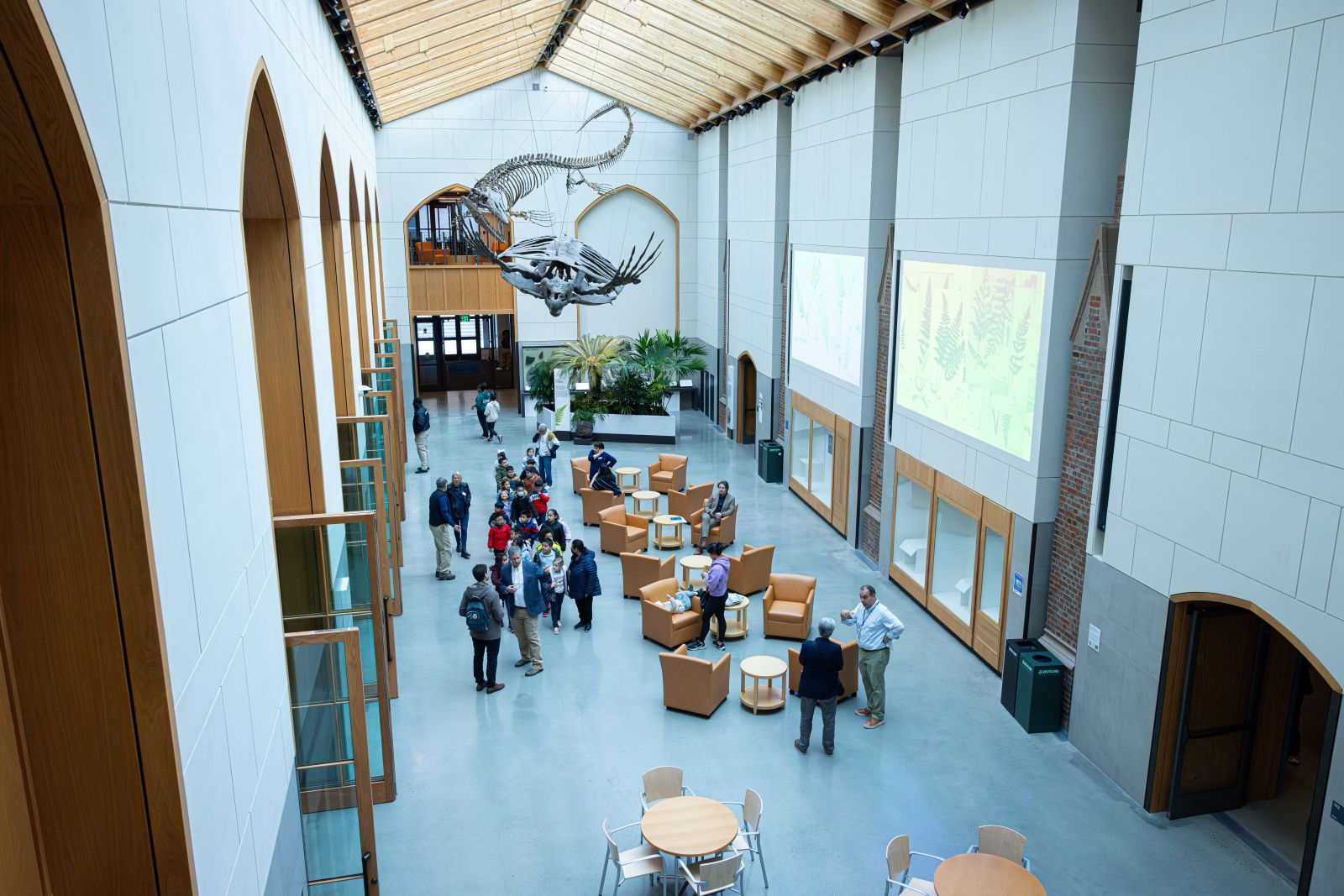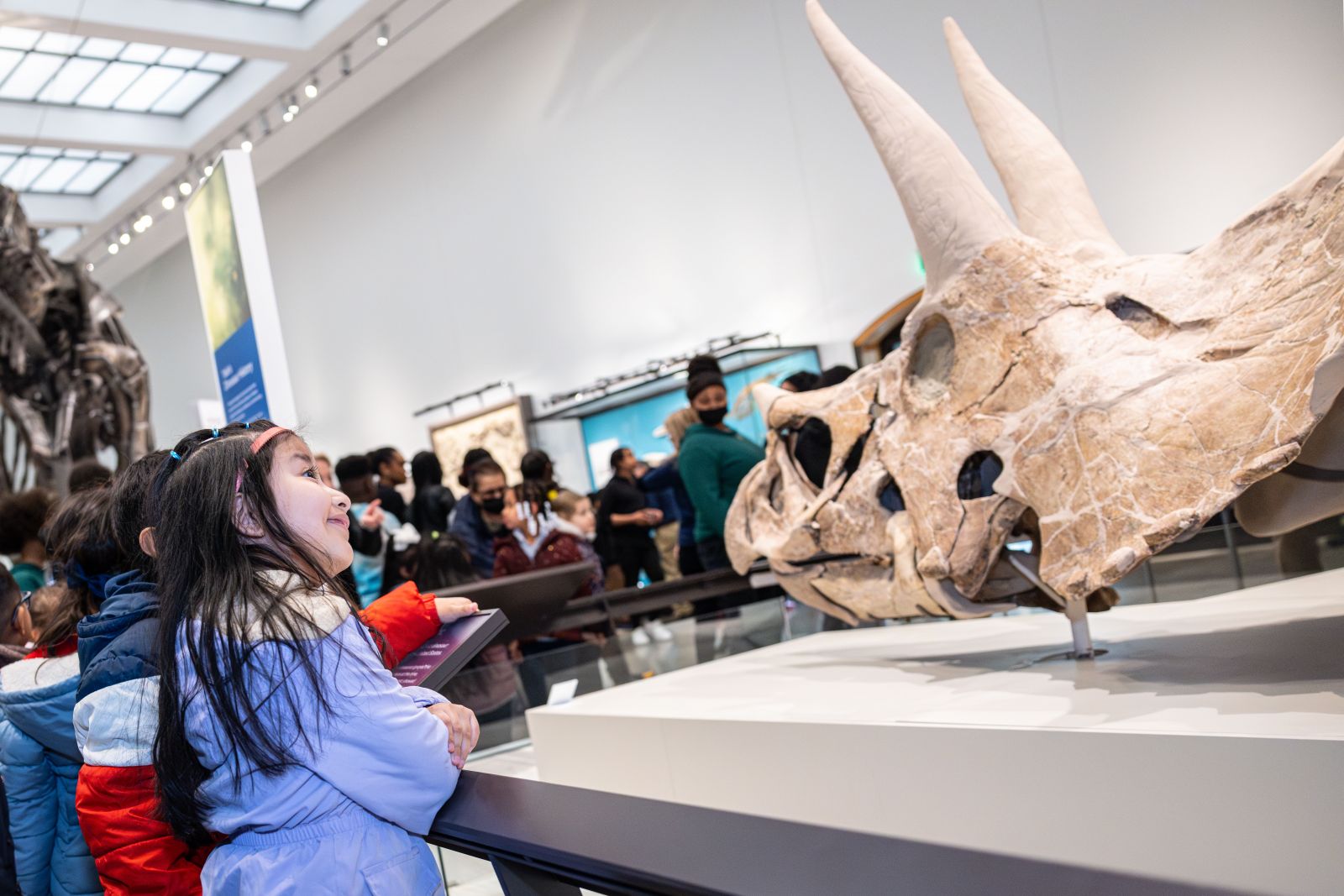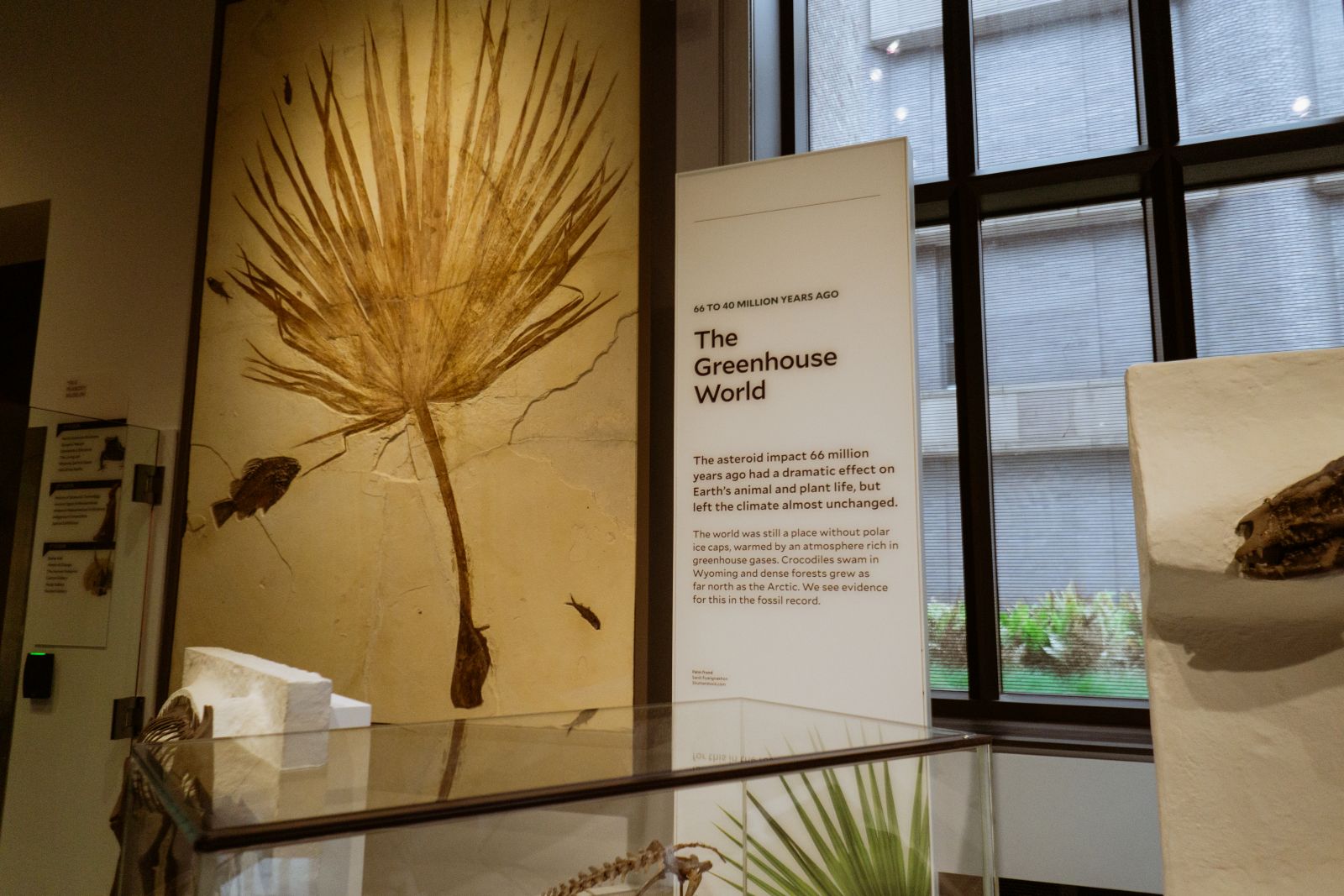
After a four-year renovation and expansion, the Yale Peabody Museum features a lot more fossils—and is designed to use a lot less fossil fuels.
The historic modernization not only added new galleries, introduced new collections, and improved accessibility, it made the building itself much greener.
Over time, the new Peabody is expected to cut its energy use intensity (the amount of energy used per square foot, per year) by half compared to the pre-renovation museum, despite expanding gallery space by 60,000 square feet. Newly installed systems are conserving water both inside the museum and around its three-acre landscape. And new bird-safe glass is helping to bring down fatal window collisions.
This past summer, the U.S. Green Building Council recognized the Peabody’s sustainable design with LEED Gold certification, the second-highest designation a building can earn. In doing so, the Peabody became one of only about 100 museums in the U.S. to achieve LEED Gold certification or higher. That’s a significant evolution for a structure once heated with coal-fired boilers and windows so drafty they would ice over on the inside during winter.
“The overall vision for the renovation project was to focus on connecting the museum more fully with the mission of Yale. With 50 percent more exhibition space and new classrooms within the galleries themselves, the museum has enhanced the ability of students, scholars, and researchers to directly work with and learn from our collections,” says David K. Skelly, the Frank R. Oastler professor of ecology and director of the Yale Peabody Museum.
“It hasn’t always been easy to get our beloved museum updated for the modern era,” Skelly adds. “When this building was constructed in the 1920s, they couldn’t have anticipated the activities and programs of the 21st century. The work we’ve done helps the Peabody to become greener and more accessible in every way.”
Since reopening with free admission to the public, more people than ever are accessing the Peabody’s collections. Prior to the renovation, the museum welcomed around 130,000 visitors a year; in the first six months after reopening, it has already greeted 285,000.
More than any place at Yale, the Peabody serves as a gateway to campus, bringing university research and scholarship to a wide audience. With the museum’s renovation, the Peabody experience now invites the public to consider how the building itself fits into the story of Earth’s ever-changing climate—and how Yale can test and model planetary solutions through its built environment.
Reducing energy and waste
Museums are energy intensive by their nature because they require strict temperature and humidity levels to preserve their collections. To maintain those conditions, the Peabody installed seven state-of-the-art air handling units in a room above the Burke Hall of Dinosaurs and its famous Brontosaurus skeleton. The new Peabody also features an improved building envelope—the physical barrier between the museum’s interior and the exterior environment.
“One of the main things we requested in the renovation was to revise the building envelope with better insulation and a vapor barrier,” says Peabody Director of Collections & Research Susan Butts, who was part of a green team that provided input on the project’s design. “No one gets excited about a building envelope because you can’t see it. But that has a significant impact on energy use.”

The air-handling upgrade has also made it possible to add live plants to the new atrium-like central gallery. Staff at Marsh Botanical Garden provided the plants, which were chosen to thrive in the specific conditions of the space and because they are relatives of the fossil plants on display close by.
The vast majority of the Peabody’s collection—some 14 million specimens—are not on display, but instead kept in archival quality cabinets in climate-controlled collections rooms in the Peabody and in the adjacent Environmental Science Center. These air-tight cabinets can hold climatic conditions for a longer period of time without fluctuations, Butts explains, providing further energy savings and adding resiliency by protecting the specimens in case of a power outage. The stability of the conditions within the cabinets also allows the Peabody to relax storage room temperatures and humidity ranges, allowing for even more energy savings.
The decision to renovate within the museum’s existing structure was a major one and dramatically reduced waste. Sixty-nine percent of the existing building’s structure, enclosure, and interior materials was repurposed, and 79% of construction debris was salvaged for reuse. Butts is especially pleased with the museum’s polished concrete floors, which repurposed the existing subflooring—replacing carpet squares that periodically had to be thrown out and refreshed.
Reusing existing building materials not only cut down on waste, Butts notes, it lowered the project’s embodied carbon—the total greenhouse gas emissions generated throughout the life cycle of building materials.
Conserving natural resources and biodiversity

The Peabody’s renovation—which was made possible by a landmark $160 million gift from philanthropist Edward P. Bass ’68 and designed by Connecticut-based Centerbrook Architects and Planners—expanded the museum’s galleries and added five classrooms, new research labs, and a new education center for K-12 students from the New Haven area.
It also reimagined the museum’s role in conserving natural resources in ways that build resilience for droughts and other climate-related disruptions.
Walking the museum’s landscape, Butts points out that the site was designed to prioritize native plants and mitigate stormwater runoff. Over its 3.6 acres, the Peabody has installed systems capable of capturing and storing rain that runs off the roof and surface areas. Rainwater then gradually infiltrates into the ground over time to sustain the plantings, which include native species such as the pollinator-friendly serviceberry.
The museum also installed low-flow water fixtures indoors. While the Peabody is now using more water overall—due to additional restrooms and lab spaces—it is using 30% less than it would be had it not installed those water-saving fixtures.
Outside, the museum’s new landscape design will lower water use by 65%. More than 50 percent of the museum’s footprint is now dedicated to open green space and pedestrian-oriented hardscape, and bike parking was expanded to 54 spaces.
Throughout the building, the museum installed bird-safe glass embossed with a horizontal frit pattern that helps birds to perceive the glass as a physical barrier and reduces the risk of collisions. Already the glass has produced some encouraging outcomes. Kristof Zyskowski, the Peabody’s ornithology collections manager, says research assistants with the Yale Bird-Friendly Building Initiative have recorded only five collisions over the past three migration seasons.
“That is a low number and an encouraging result,” Zyskowski says. “It looks like the new fritted glass is working.”
Telling the story of Earth’s ever-changing climate
The Peabody’s sustainable design is a complement to the story told inside the galleries about Earth’s ever-changing climate and how events—both natural and human-caused—have determined what kind of life our planet can support.
During a recent tour for museum staff, Chris Norris, the Peabody’s director of public programs, pointed to Rudolph Zallinger’s famous “Age of Mammals” mural for clues about how Earth’s climate had transformed over millions of years.
Don’t look at the mammals, Norris encouraged his colleagues. Look instead at the landscapes. The left side of the mural depicts a green and lush environment—indicative of a warmer planet with no ice caps, when more water circulated. On the right side, the landscape is brown and arid—depicting a dryer and cooler planet after much of that water had frozen at the poles.
“This mural is one of the best representations of climate change you could hope for,” Norris said.

The museum’s fossils provide visitors with further examples of how Earth’s climate has changed. A palm frond found in Wyoming and a spadefoot toad found in South Dakota show that, millions of years ago, these environments were far warmer and wetter than they are today.
The museum’s Human Footprint gallery tells the story of how humans have altered—and been altered by—Earth’s environment, from contributing to the extinction of mega-fauna such as the giant moa to the ways that human agriculture changed the genetics of corn.
Near the museum exit, a touchscreen kiosk about anthropogenic climate change brings Earth’s timeline from the industrial revolution to the present. Using New Haven as a case study for the inequities that stem from climate change, the exhibit explores how lower-income communities feel disproportionate impacts of climate change, with less tree shade, higher surface temperatures, and worse air quality. All of that puts city dwellers at higher risk for asthma and other health problems.
The kiosk then leads visitors to solutions—including the Yale-affiliated nonprofit organization Urban Resources Initiative, which has planted more than 10,000 street trees in New Haven through its GreenSkills initiative, a local green jobs program that employs high school students and adults with employment barriers.
“Museums like the Peabody play a crucial role in educating future leaders and inspiring visitors to be creative about seeking solutions to climate challenges,” says Amber Garrard, director of the Yale Office of Sustainability. “By using the physical environment to test solutions and model new approaches to building and design, the Peabody has connected us more deeply to Yale’s mission to improve the world and opens the doors for everyone to be part of that.”